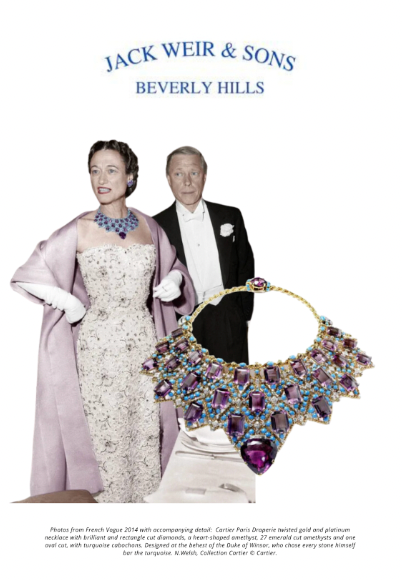Amethyst, a gemstone that captivates us all with its stunning and varied purple hue, has fascinated humanity for centuries. Today, its rich color and accessibility make it a popular choice for jewelry and decorative home items. Today we’re going to take a look at the vivid world of amethysts, the February birthstone, and explore the history, properties and beauty of this incredible stone.
What is Amethyst?
Amethysts are a member of the quartz family and are renowned for their striking purple color, which can range from light lavender to deep violet. The presence of iron and other trace minerals within the quartz gives amethysts their characteristic color. Historically, amethysts were as highly valued as diamonds and were favored by royalty and clergy alike for their beauty and supposed mystical powers - and of course, the most regal of all colors, purple.

Geology Science.com
Where is Amethyst Found?
Amethysts are primarily found in geodes within volcanic rocks. Until the 19th century, most Amethysts came from Russia. At that time, amethyst was as rare and highly regarded as diamonds and emeralds. It wasn’t until formations were found in Brazil around the end of the 19th century that made the stone more accessible as we know it today. Today, the best-quality amethysts are typically mined in Brazil, Uruguay, and parts of Africa, though there are also Amethysts formed elsewhere in North America- most notably at The Four Peaks Mine in Arizona. The amethyst crystals found here are formed in volcanic rocks that are approximately 1.4 billion years old and are a great eye into the geological history of the region. Each location produces Amethysts with unique characteristics and hues, contributing to the stone’s diverse appeal.
What is Amethyst Used for?
Amethysts are a popular choice for all types of jewelry, including rings, necklaces, earrings, and bracelets. Their versatility and durability (measuring 7 on the Mohs scale of hardness) make them suitable for everyday wear. The largest cut amethyst is currently on display at the Smithsonian Museum and weighs 401.52 carats.

Photo Credit: Ken Larson, Smithsonian Institute
Historical Significance
Amethysts have a rich history that dates back to ancient civilizations. The Greeks believed that amethysts could prevent intoxication, and the name "amethyst" originates from the Greek word "amethystos," meaning "not intoxicated." In medieval times, amethysts were thought to symbolize piety and were used to decorate churches and crosses. Amethysts have a storied place in various cultures and mythologies. They are often associated with qualities like calmness and clarity. In Renaissance art, amethysts symbolized humility and modesty. In other cultures, amethysts are considered stones of protection and are used in amulets and talismans. Leonardo da Vinci once said that amethyst helped to quicken wit and get rid of negative thoughts.
One of the more famous pieces of Amethyst in recent history is the suite of Amethyst and Turquoise jewelry commissioned by The Duchess of Windsor, Wallis Simpson from Cartier in 1947.

Design Versatility
Amethysts are incredibly versatile in jewelry design. Their range of shades from light to dark purple complements both gold and silver settings. Amethysts can be cut into various shapes, including traditional rounds, ovals, and more modern cuts like cushions or emeralds, offering a plethora of design options. In addition, Amethysts can be cabochon cut for a rounder look without facets, or worn in its natural geode form. As the birthstone for February, amethyst jewelry makes a great gift for your favorite February babies. Amethysts are also associated with the sixth and seventeenth wedding anniversary and are believed to symbolize peace, courage, and stability - things that are always welcomed in a marriage!


Healing and Spirituality
In the realm of crystal healing, amethysts are believed to purify the aura of any negative energy and create a protective shield around the body. They are often used in spaces to promote relaxation and stress relief. The amethyst is said to stimulate the third eye, is said to cure insomnia and provide good protection against recurring nightmares and dark vivid dreams.
Caring for Your Amethysts
To maintain the beauty of amethysts, proper care is essential. Amethysts should be kept away from direct sunlight as prolonged exposure can cause the color to fade. When cleaning amethyst jewelry, use warm soapy water and a soft brush, avoiding harsh chemicals. Store amethyst jewelry separately from other pieces to prevent scratching. It’s best to wrap them in a soft cloth or place them in a fabric-lined jewelry box.
Amethysts, with their enchanting purple hue and rich history, are a timeless addition to any jewelry collection. Their versatility, durability, and beauty make them a favorite among gem enthusiasts and casual admirers alike.
—--
At Jack Weir & Sons, we’ve spent the last 40 years traveling to Europe and all over the world, curating extraordinary estate jewels. JWS is where the old world meets the new world. Celebrate life, preserve history, and discover your own priceless heirloom jewel. We are extremely grateful for our clients and the ability to help people to celebrate their special moments through one-of-a-kind jewelry. To share that gratitude and our strong family values, we chose to partner with Baby2Baby. So far, we've donated $125,000. A portion of every sale goes towards children living in poverty to provide them with diapers, clothing, and all the basic necessities that every child deserves.
We offer in-person and Virtual Appointments and are happy to answer any questions about your favorite jewel.
JWS Flawless Protection Plan:
- Free Sizing & Overnight Shipping
- 7-Day 100% Return Policy
- 30-Day Exchange for Credit
- Free Appraisal with Purchase
- 100% Authenticity Guaranteed







































